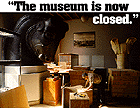 Continued
Continued The University of Chicago Magazine June 1996
The University of Chicago Magazine June 1996 Continued
Continued
"we had to tell them right out that if a piece is about to fall, you get out of the way. They were all saying they'd throw their bodies under it, and we said no-we don't want any human sacrifices."
A visit with the institute's registrar, Ray Tindel, becomes a breathless, movable feast of information. In the span of 90 minutes, logistical puzzles that just can't wait summon Tindel, AM'72, PhD'89, to every nook of the museum's vast basement, aboard a groaning freight elevator, and finally upstairs to the galleries. "Follow me" begins to resonate like a running gag.
In Tindel's job as registrar-a position he's held since 1986, after working part time at the institute since the early 1970s-he deftly keeps track of each of the collection's 103,853 registered artifacts (only a tenth of which are ever displayed), as well as their accompanying documentation. It's a busy enough job in normal times, but these are far from normal times.
"Yes, I knew it would be absolute hell," says Tindel, answering a more mildly worded question. "It's sort of like being in the whitewater, paddling furiously, and if you can keep the boat from capsizing you'll be okay."
Among the most critical components keeping the project on track is a computerized catalogue of artifacts that Tindel began assembling before the restoration began. Over time, the previous, paper catalogue had developed major inconsistencies, forcing Tindel to start more or less from scratch. Even with help from staff and volunteers, the system took four years to create. It allows the staff to locate each object's precise whereabouts-even during the confusing shuffles of the past two years.
Packing began in the basement, Tindel explains, where the bulk of the objects were stored. The Persian gallery was later shut down to accommodate the overflow. An estimated 3,800 boxes will eventually be packed: All will be moved into the Egyptian gallery, a location picked because it is furthest away from the south-wing site, where the bumps and grinds of construction could threaten the stability of fragile objects.
Along with the tedium involved in storing these objects is the pressure of knowing they "represent an enormous investment in time and money, and sometimes lives," says Tindel. "If we lose them or damage them, they're gone. There aren't any more like them. They cannot be retrieved or rebuilt."
With help from volunteers and Robin Kasson-a work-study student who graduates from the College this spring-assistant curator Emily Teeter, PhD'90, has packed almost all of these priceless relics. Each must be bagged, tagged, swaddled in bubblewrap, and safely tucked into its cardboard cradle for a sunless, two-year nap.
As numbing as this sounds, Teeter says she often experiences joy in the task. "It's given me an incredible opportunity to really see what the collection is. Just the experience of handling that much material is very educational, very illuminating. For example, with pottery, you develop a sense-if you pick up something you can tell almost immediately that there's a crack in it, just from how it feels.
"All the time I was packing," Teeter adds, "I was making lists of interesting things to put on exhibit." For example, she came across several alabaster vessels "that were really a tour de force of carving. Whoever found them didn't know much about them, which is why I assume they were never displayed. I'd really like to exhibit some of these type of objects-they're beautiful and kind of mysterious."
Probably the museum's original curators would have turned up their noses at such a comment. Designed to reflect the institute's serious scholarly pursuits, the old exhibits were "very, very scientific-frankly, a little dry-but the biggest problem is they took a tremendous amount for granted," says Teeter. "They must have assumed either that the museum's visitors were professional Near Eastern scholars who knew all of these terms and concepts, or else they just didn't see one of its functions as educating the public. And so one of the things we're going to do is make the museum more accessible-and yet not dumb it down."
A more immediate challenge is maintaining the public profile of a museum that, except for its gift shop, will be shut down for two entire years. "A sign on the front door isn't going to do it," Teeter says. The museum's education office will step up its outreach programs in area schools and community centers. Also, a series of exhibitions starting this fall at the University's Smart Museum will highlight different areas of the collection and, Teeter adds, "should give us a chance to experiment a bit in how our own gallery exhibits may be reorganized once we reopen."
For visitors stopping by who might be unaware of the closing, William Sumner is considering installing a computer in the lobby that offers a virtual tour of the museum as it looked before it closed. Prior to the galleries' dismantling, museum photographer Jean Grant took pictures of each gallery alcove for just such a purpose.
In the meantime, Sumner and his staff are bracing themselves for two years' worth of questions like, "When are you going to reopen?" or "Just what is it that you're doing in there?" To the latter, Sumner responds: "We're working on the third millennium. That's my answer. As archaeologists, we're all used to dealing in the long range.
"This is not an immediate emergency-that we've got to save this stuff or in ten years it will all be gone. We're talking about 50, 100, 200 years down the road. But at some point somebody has to take the responsibility," says Sumner, "and I'm proud to be in the generation that has done it."
Return to opening of, "The Museum is now closed."
Go to:
Return to June 1996 Table of Contents